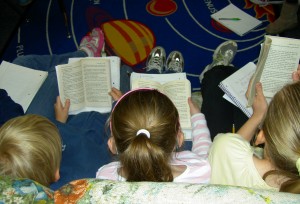Research Backs Structured Literacy
Written by Jennifer Salisbury
Published on July 15, 2015
Latest Research Shows How the Brain Learns Reading
 The latest study in brain research gives greater understanding to how the brain responds to reading instruction. Stanford University Professor Bruce McCandliss and other colleagues from Texas and New York, used two different approaches to teach subjects a pretend language, simulating how a beginning reader would encounter novel words. The first instructional approach tried in this study was similar to the Structured Literacy method of instruction based on sound-letter patterns, the second was memorization, similar to the Whole Language approach to reading. The initial findings on how teaching methods impact the brain are:
The latest study in brain research gives greater understanding to how the brain responds to reading instruction. Stanford University Professor Bruce McCandliss and other colleagues from Texas and New York, used two different approaches to teach subjects a pretend language, simulating how a beginning reader would encounter novel words. The first instructional approach tried in this study was similar to the Structured Literacy method of instruction based on sound-letter patterns, the second was memorization, similar to the Whole Language approach to reading. The initial findings on how teaching methods impact the brain are:
Optimal activation in the brain occurs when instruction focused on the word’s structure/ reading the word phonetically (similar to Structured Literacy Approach).
Learning to decode through explicit instruction in sound-letter patterns activates areas the left hemisphere of the brain. The left side of the brain, is the center for language which is wired for reading and an area that shows high activity in proficient/skilled readers.
Whole word memorization, showed inefficient/less optimal brain activation, when used as a strategy to learn a new word (similar to Whole Language Approach).
Reading words through memorization, shows more activity in the brain’s right hemisphere. This pattern is consistent with struggling readers. Learning to read words by memorization did not show optimal brain activity.
Learning to read by sound-letter associations, positively impacts future reading of novel words.
Breaking down a word into individual phonemes (sounds), not only helps a child to figure out the word initially, but is shown to impact the future reading success of the word as well. Having tools to decode words is a transferable skill.
The method and delivery of phonics instruction should be intentional.
Not all phonics instruction is equal! The research shows the importance of intentionally directing the learner’s attention to the sound-letter pattern.
The Structured Literacy approach addresses all of the components that research shows is most effective in learning how to read! Working with professionals who have experience and are trained in Structured Literacy approach, can help your child become a proficient reader. Learn how Lexercise uses Structured Literacy to strengthen the brain and give your child a free dyslexia screener HERE!
References:
Higgins, J. (2015, June 5). New brain study sheds light on how best to teach reading. Retrieved July 15, 2015, from http://www.seattletimes.com/education-lab/how-students-are-taught-affects-reading-efficiency-new-brain-study-finds/?utm_source=email&utm_medium=email&utm_campaign=article_title
Wong, M. (2015, May 28). Stanford study on brain waves shows how different teaching methods affect reading development. Retrieved July 15, 2015, from http://news.stanford.edu/news/2015/may/reading-brain-phonics-052815.html
Improve Your Child’s Reading
Learn more about Lexercise today.
Schedule a FREE
15-minute consultation


